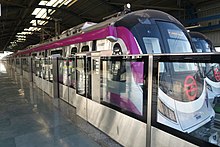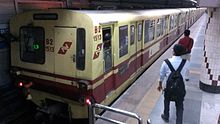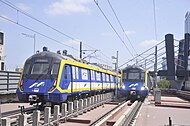
A | B | C | D | E | F | G | H | CH | I | J | K | L | M | N | O | P | Q | R | S | T | U | V | W | X | Y | Z | 0 | 1 | 2 | 3 | 4 | 5 | 6 | 7 | 8 | 9




Urban rail transit in India plays an important role in intracity transportation in the major cities which are highly populated. It consists of rapid transit, suburban rail, monorail, and tram systems.
According to a report published in 2021, a total of 2.63 billion people traveled annually in metro systems across India's seventeen major cities, placing the country as one of the busiest urban rapid transit hubs in the world in terms of commuters. The combined length of 905 kilometres (562 miles) of metro systems in India makes it the third longest in operation in the world.[1]
The Ministry of Urban Development's Urban Transport wing is the nodal division for coordination, appraisal, and approval of Urban Transport matters including Metro Rail Projects at the central level. All the interventions in urban transport by the Ministry of Urban Development are carried out as per the provisions of the National Urban Transport Policy, 2006.[2]
The Delhi Meerut RRTS is the fastest Urban Transit system in India currently that can run at a speed of 160 kmph with average operational speed of 100 kmph.
Terminology
Indian cities have various types of urban transit systems operational, under construction and planned. These systems are being implemented based on the population of a city, financial feasibility and demand.
| Urban transit type | Capacity | Speed | Frequency of stations / stops | Range | Right of way | Rail based | Cost to build and operate |
|---|---|---|---|---|---|---|---|
| Metro | High | Moderate | High | Medium | Yes | Yes | High |
| Suburban Railway | High | Moderate | Medium | Long | No † | Yes | Moderate |
| Medium-capacity metro | Medium | Moderate | High | Medium | Yes | Yes | High |
| Light rail | Medium | Moderate | High | Medium | Partial ‡ | Yes | Moderate |
| Monorail | Medium | Moderate | High | Medium | Yes | Yes | High |
| Regional rapid rail | High | High | Low | Long | Yes | Yes | High |
| Tram | Low | Slow | High | Short | No | Yes | Low |
| Bus Rapid Transit | Low | Moderate | High | Medium | Yes | No | Low |
| Metro Neo | Low | Moderate | High | Medium | Yes | No | Moderate |
| Water Metro | Low | Slow | Medium | Medium | Yes | No | Low |
† Note: Suburban rail in India utilises the broad gauge network of Indian Railways and mostly shares the network and infrastructure with the rest of Indian Railway services.
‡ Note: Light Rail systems are mostly fenced and can be built with complete right of way if preferred so.
- Rapid transit: The rapid transit or popularly known as metro in India, is an urban high-capacity rail system, commonly operated in metropolitan cities. These systems are segregated from Indian Railways and have their right-of-way.
- Suburban Railway: Suburban rail or popularly known as local train system in India, is an urban rail transit system where the suburbs are connected to the city's centre. These systems are linked to and operated by Indian Railways. Example: Mumbai Suburban Railway
- Medium-capacity rail: It is a rapid transit (metro) system which has a capacity higher than light rail but lower than rapid transit system to serve a medium demand. It is built considering the future rise in demand, so that it can be converted into a regular metro. Example: Rapid Metro Gurgaon
- Light rail: Light rail which is also known as Metro Lite is used in cities that have low demand. It is a combination of rapid transit and tram systems. It has a higher capacity and speed compared to tram services and has dedicated tracks that are mostly fenced. Example: Srinagar Metro
- Monorail: This system has trains running on a single rail/beam. It has found its application in medium capacity transport, but due to low efficiency and high costs, it has been sidelined in India. Example: Mumbai Monorail
- Regional rapid rail: This system is operated either between two similarly sized cities, which are close to each other or between an urban city and smaller cities lying nearby. Example: Delhi–Meerut RRTS
- Tram: These systems are one of the oldest modes of urban transport in India. They are low capacity, slow-moving trains which run on tracks that are embedded in the urban streets. Example: Kolkata Tram
Non-rail based urban transit
- Bus Rapid Transit : The Bus Rapid Transit systems in India use conventional buses or high capacity buses and have their own right-of-way, separated from the rest of the traffic. Example: Ahmedabad Bus Rapid Transit System
- Metro Neo : These are the Bus Rapid Transit systems that use overhead wires with power supply, similar to a trolleybus but with a higher capacity. They also have either a complete or partial right-of-way. Example: Greater Nashik Metro
- Water Metro : A water-based urban transit system usually implemented in cities which are situated on river banks. These systems are basically integrated ferry systems. Example: Kochi Water Metro
History
Early history

The first-ever mode of the urban rail transit system in India was commuter rail (or suburban rail), built in Mumbai on 16 April 1853. The first passenger train was flagged off from Bori Bunder (present-day Chhatrapati Shivaji Terminus in Mumbai) from where it travelled to Thane, covering a distance of 34 km in an hour and fifteen minutes. This made it the Asia's first suburban railway.[3] At the turn of the 20th century, tram systems began to sprawl across the four major cities of India, viz. Delhi, Kolkata, Chennai and Mumbai, and helped local population to meet their intracity transportation needs. Horse-drawn tram was first introduced in Kolkata in 1873 and the electric trams began to operate in Chennai in 1895, later the cities of Mumbai, Kanpur, and Delhi saw trams being introduced. These services were discontinued in all Indian cities between 1933 and 1964, except for Kolkata where they operate on streets to the present day as heritage.[4]
Metro and mass rapid transit

In September 1919, during a session of the Imperial Legislative Council at Shimla, a committee was set up by W. E. Crum that recommended a metro line for Kolkata.[5] The next proposal for a metro system was mooted by government of West Bengal in 1949-50 and a survey was conducted by French experts. However, the proposal could not be brought into the effect and India had to wait for its first metro service. It was twenty three years later when the foundation stone was laid in Kolkata in 1972 to commence the construction of the ambitious metro system. On 24 October 1984, India saw its first metro system operational in Kolkata. After several struggles and bureaucratic hurdles, a stretch of 3.4 km was opened with five stations on the line.[6] On 1 November 1995, the Chennai MRTS began its operations, becoming the first elevated railway line in India and also the country's longest elevated mass rapid transit corridor spanning 17 km.[7][8]
The first concept of an urban rapid transit system in Delhi came out during 1969,[9] when a traffic and travel characteristics study was conducted. The bus systems which catered the public transportation in the city soon began to run out of capacity and the traffic was on the rise, this soon became a growing concern. The concepts for an urban transit system were considered as the need for the country's capital.[9] After planning, a proposal was made in 1984, which revealed plans for constructing three underground corridors and augmentation of the existing suburban rail system. The construction began on 1 October 1998 and the first line was operational on 24 December 2002.[6][10] With 348.12 kilometres (216.31 mi), the Delhi Metro went on to be the longest and by far the busiest metro system in India, which also served as a role model to other Indian cities.[11]
Monorails and their replacement
While the political capital of India was expanding on its success by constructing new metro lines, suburban railways remained as the dominant mode of transport in the financial capital, Mumbai. According to Mumbai Metropolitan Region Development Authority (MMRDA) the city bus services operating in narrow and crowded areas of the city were slow-moving and caused traffic congestion hence a rapid transit system was necessary. Since the city already had planned metro services and since the suburban railways also connected major parts of the city, a feeder system to these services was proposed in the form of Monorail.[12] After the construction was completed, On 1 February 2014, Mumbai Monorail became the first of its kind in India.[13][14]
In the early 2010s, many cities had conceived the plan to build monorails as the major urban transportation solution to their cities. However, Mumbai's monorail soon began to reveal the underlying problems of a monorail system.[15] The issues such as low ridership, inefficient track maintenance (accessibility of the tracks during maintenance as well as the time taken to repair the tracks), train slowing down at the switches and for the fact that the monorail tracks had to be entirely elevated with a dedicated depot and set of rolling stocks, raised the concerns on feasibility, cost of construction and operation of the new lines significantly. Hence, almost all of the monorail systems around the world are seen in amusement parks or similar theme parks instead as a solution to the urban public transportation.[16] A traditional light rail system soon emerged as the efficient mode but with cheaper cost and greater capacity than what monorail offered. As a result, many Indian cities replaced their monorail projects with either a regular metro or a light rail system.[17]
Rapid transit



There are currently 17 operational rapid transit (Officially and popularly known as 'Metro') systems in seventeen cities across India, with Delhi Metro being the largest.[18] As of March 2024, India has 902.4 kilometres (560.7 miles) of operational metro lines in 17 cities.[19][20] India's metro network is the third longest in the world, behind USA and China. A further 779.27 km of lines are under construction.
Apart from the Kolkata Metro (which has its own zone under Indian Railways),[21] these rapid transit metro lines are not operated by Indian Railways, but a separate set of local authorities. In addition to their metro systems, the cities of Chennai and Hyderabad have mass transit systems operated by the Indian Railways, known as the Chennai MRTS and the Hyderabad MMTS, respectively. The first rapid transit system in India is the Kolkata Metro, which started operations in 1984. Kolkata Metro also currently has the only underwater metro line in the country. The Delhi Metro has the largest network in the entire country.[22]
Implementation
In 2006, the National Urban Transport Policy had proposed the construction of a metro rail system in every city with a population of at least 20 lakh (2 million) people.[23][24]
From 2002 to 2014, the Indian metro infrastructure expanded by 248 km.[1]
Later on 11 August 2014, Union Government had announced that it would provide financial assistance for the implementation of a metro rail system to all Indian cities having a population of more than 1 million.[25][26] In May 2015, the Union Government approved the Union Urban Development Ministry's proposal to implement metro rail systems in 50 cities, with the majority of the planned projects were to be implemented through special purpose vehicles, which will be established as 50:50 joint ventures between the Union and respective State Government. The Union Government would invest an estimated ₹5 lakh crore (US$60 billion).[27][28]
In a new draft policy unveiled in March 2017, the Central Government stated that it wanted state governments to consider metro rail as the "last option" and implement it only after considering all other possible mass rapid transit systems. The decision was taken due to the high cost of constructing metro rail systems.[29] In August 2017, the Union Government announced that it would not provide financial assistance to the new metro rail project unless some sort of private partnership is involved.[30][31][32]
List of systems
- As of 6 March 2024
- OP + U/C = Operational & Under-construction combined
- OP + U/C+ Planned = Operational, Under-construction & Planned Combined
